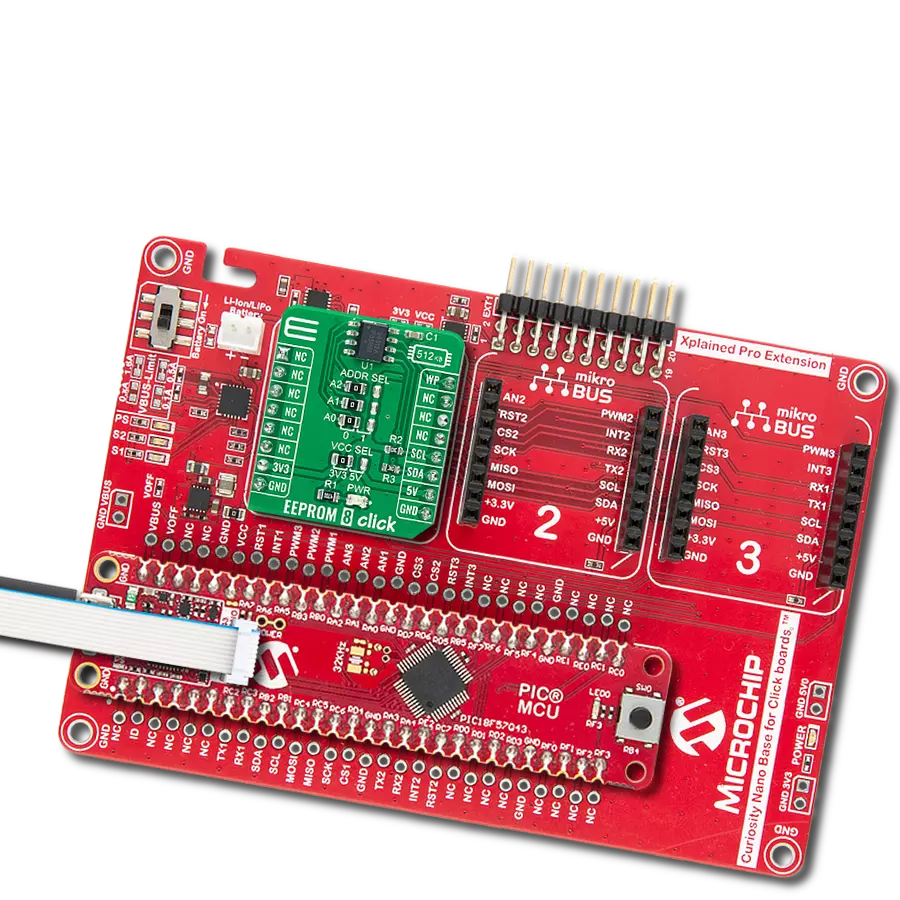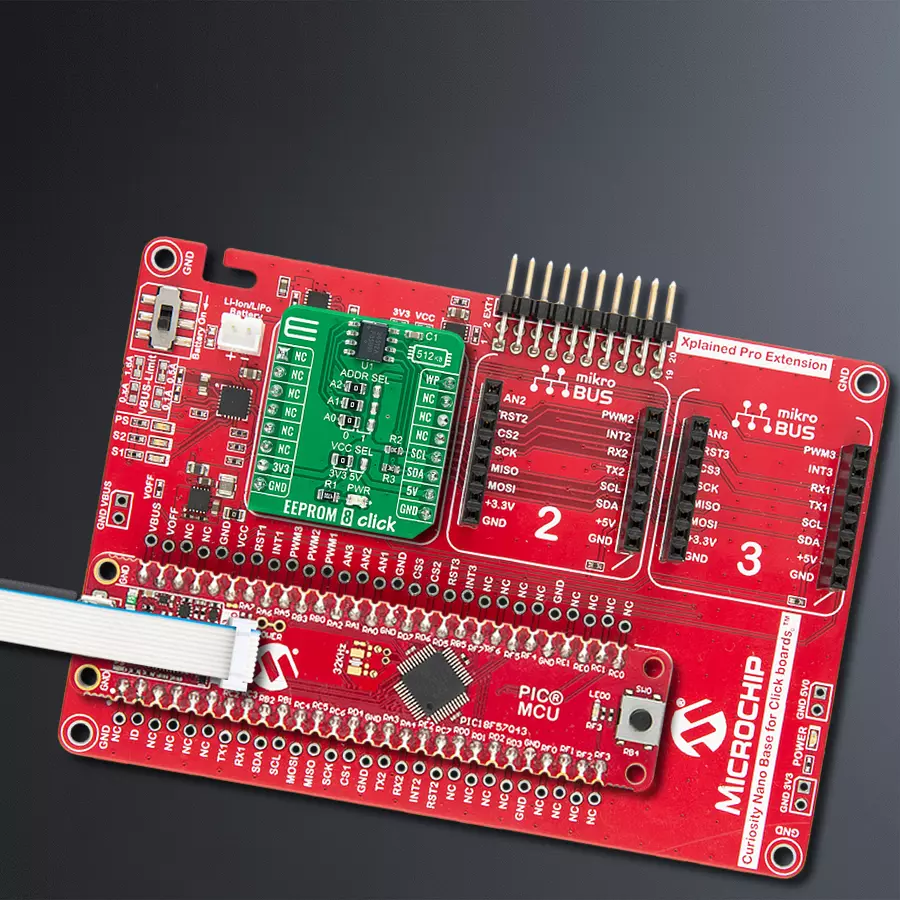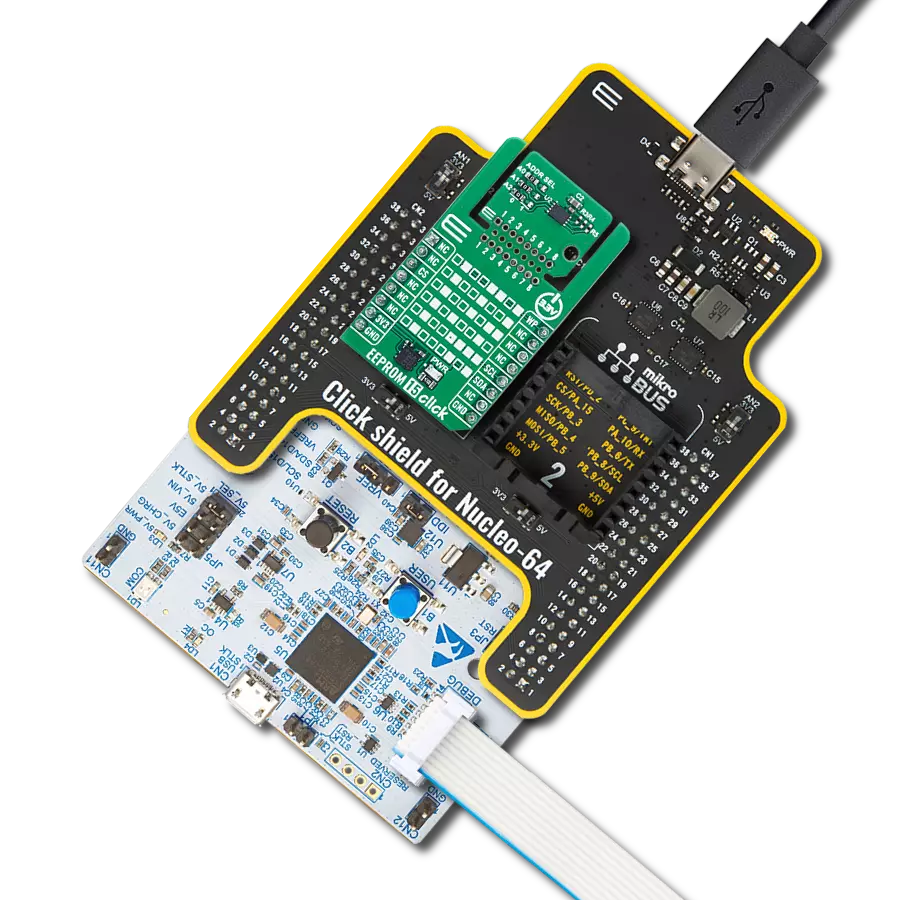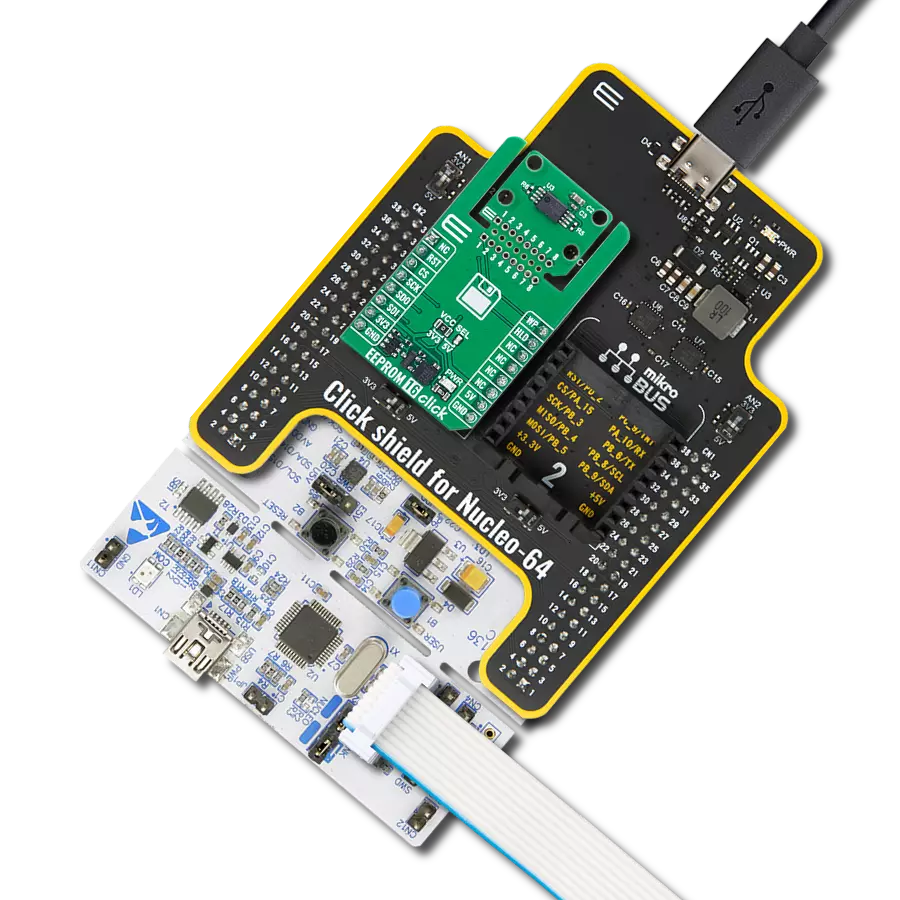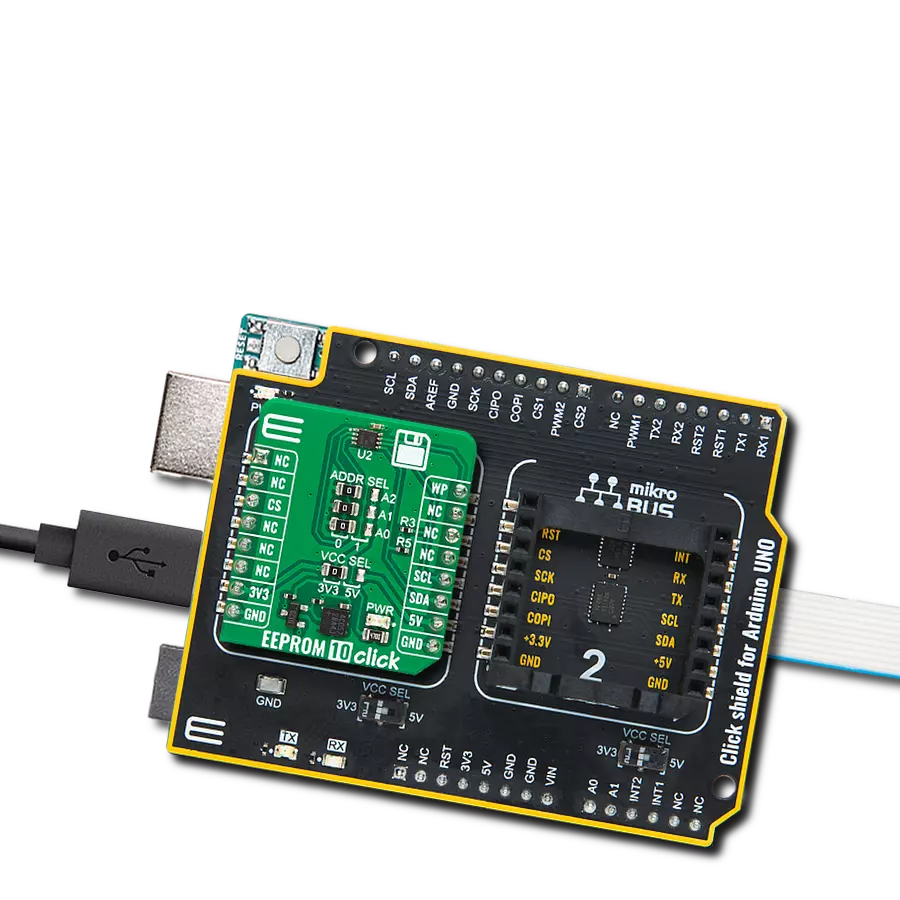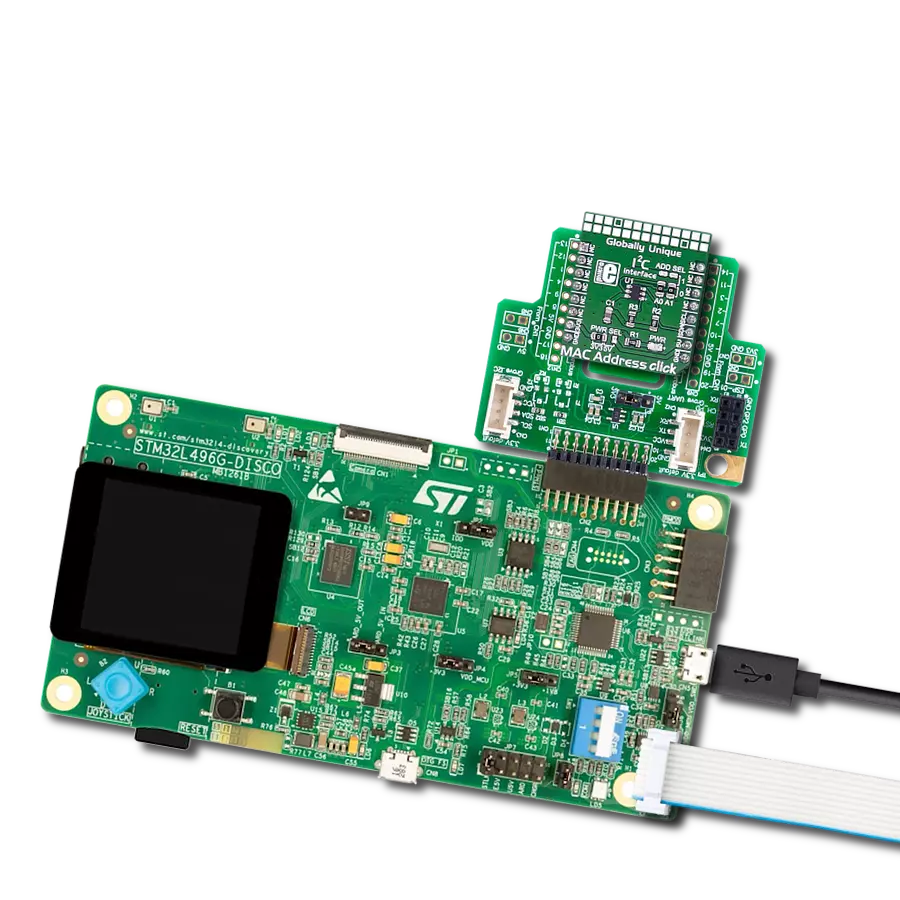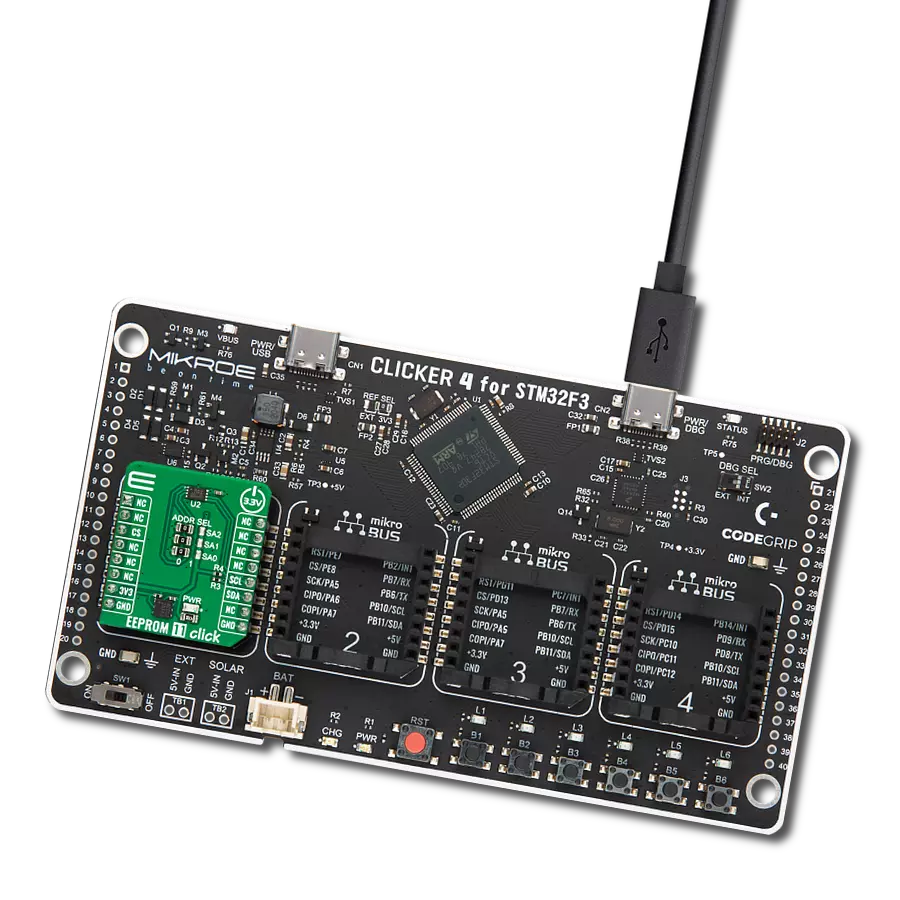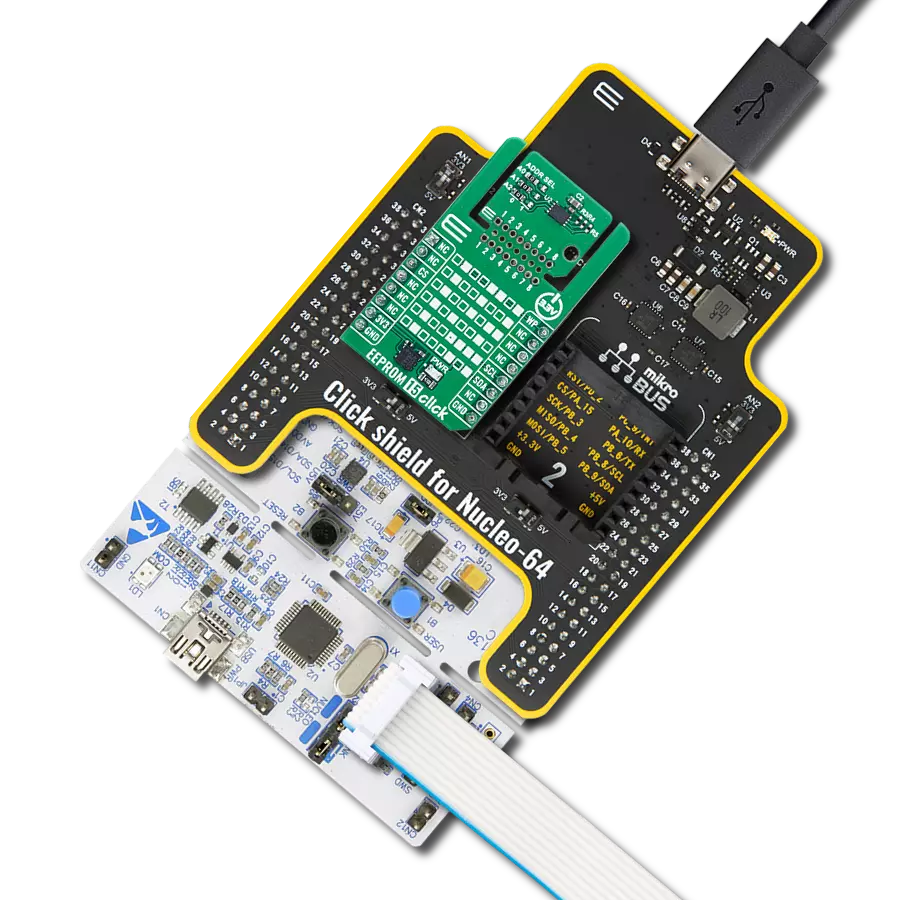Keep your data safe and secure in silicon for a century
A
A
Hardware Overview
How does it work?
EEPROM 8 Click is based on the CAV24C512, a 512-Kb EEPROM with an I2C interface and Write Protection Mode from ON Semiconductor. The CAV24C512 is organized as 65,536 words of 8 bits each and benefits from a wide power supply range and 100 years of data retention combining their unprecedented data storage with excellent energy efficiency. It is highly reliable, lasting one million full-memory read/write/erase cycles. On-chip Error Correction Code (ECC) makes this Click board™ suitable for high-reliability applications where dependable nonvolatile memory storage is essential.
This Click board™ communicates with MCU using the standard I2C 2-Wire interface that supports Standard (100 kHz), Fast (400 kHz), and Fast-Plus (1MHz) modes of operation. The CAV24C512 has a 7-bit slave address with the first five MSBs fixed to 1010. The address pins A0, A1, and A2 are programmed by the user and determine the value of the last three LSBs of the slave address, which can be selected by positioning onboard SMD jumpers labeled as ADDR SEL to an appropriate position marked as 0 or 1. Also, the configurable Write Protection function, the WP pin of the mikroBUS™
socket, allows the user to freeze the entire memory area, thus protecting it from Write instructions. This Click board™ can operate with either 3.3V or 5V logic voltage levels selected via the VCC SEL jumper. This way, both 3.3V and 5V capable MCUs can use the communication lines properly. However, the Click board™ comes equipped with a library containing easy-to-use functions and an example code that can be used, as a reference, for further development.



Features overview
Development board
PIC18F57Q43 Curiosity Nano evaluation kit is a cutting-edge hardware platform designed to evaluate microcontrollers within the PIC18-Q43 family. Central to its design is the inclusion of the powerful PIC18F57Q43 microcontroller (MCU), offering advanced functionalities and robust performance. Key features of this evaluation kit include a yellow user LED and a responsive
mechanical user switch, providing seamless interaction and testing. The provision for a 32.768kHz crystal footprint ensures precision timing capabilities. With an onboard debugger boasting a green power and status LED, programming and debugging become intuitive and efficient. Further enhancing its utility is the Virtual serial port (CDC) and a debug GPIO channel (DGI
GPIO), offering extensive connectivity options. Powered via USB, this kit boasts an adjustable target voltage feature facilitated by the MIC5353 LDO regulator, ensuring stable operation with an output voltage ranging from 1.8V to 5.1V, with a maximum output current of 500mA, subject to ambient temperature and voltage constraints.
Microcontroller Overview
MCU Card / MCU
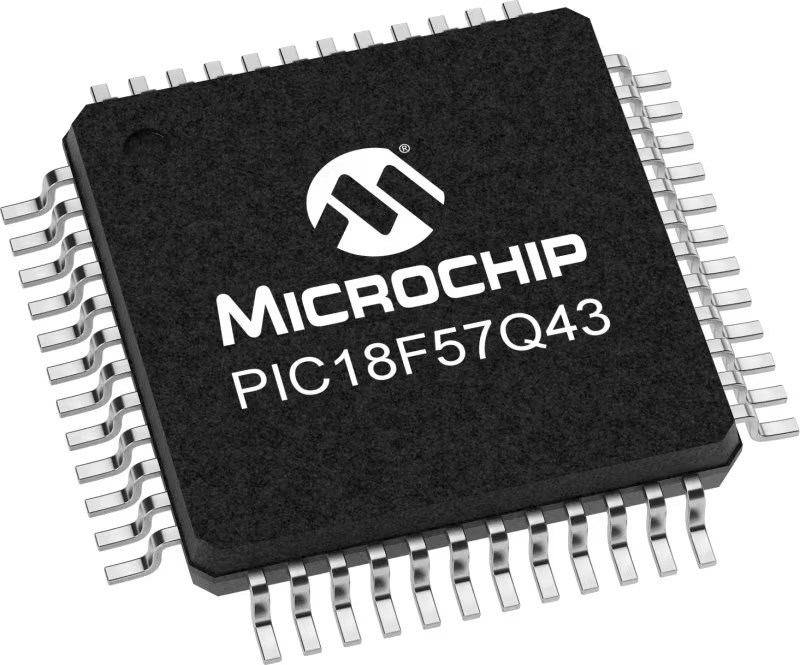
Architecture
PIC
MCU Memory (KB)
128
Silicon Vendor
Microchip
Pin count
48
RAM (Bytes)
8196
You complete me!
Accessories
Curiosity Nano Base for Click boards is a versatile hardware extension platform created to streamline the integration between Curiosity Nano kits and extension boards, tailored explicitly for the mikroBUS™-standardized Click boards and Xplained Pro extension boards. This innovative base board (shield) offers seamless connectivity and expansion possibilities, simplifying experimentation and development. Key features include USB power compatibility from the Curiosity Nano kit, alongside an alternative external power input option for enhanced flexibility. The onboard Li-Ion/LiPo charger and management circuit ensure smooth operation for battery-powered applications, simplifying usage and management. Moreover, the base incorporates a fixed 3.3V PSU dedicated to target and mikroBUS™ power rails, alongside a fixed 5.0V boost converter catering to 5V power rails of mikroBUS™ sockets, providing stable power delivery for various connected devices.
Used MCU Pins
mikroBUS™ mapper
Take a closer look
Click board™ Schematic

Step by step
Project assembly
Track your results in real time
Application Output
1. Application Output - In Debug mode, the 'Application Output' window enables real-time data monitoring, offering direct insight into execution results. Ensure proper data display by configuring the environment correctly using the provided tutorial.

2. UART Terminal - Use the UART Terminal to monitor data transmission via a USB to UART converter, allowing direct communication between the Click board™ and your development system. Configure the baud rate and other serial settings according to your project's requirements to ensure proper functionality. For step-by-step setup instructions, refer to the provided tutorial.

3. Plot Output - The Plot feature offers a powerful way to visualize real-time sensor data, enabling trend analysis, debugging, and comparison of multiple data points. To set it up correctly, follow the provided tutorial, which includes a step-by-step example of using the Plot feature to display Click board™ readings. To use the Plot feature in your code, use the function: plot(*insert_graph_name*, variable_name);. This is a general format, and it is up to the user to replace 'insert_graph_name' with the actual graph name and 'variable_name' with the parameter to be displayed.

Software Support
Library Description
This library contains API for EEPROM 8 Click driver.
Key functions:
eeprom8_write_pageThis function writes up to 128 bytes of data starting from the selected register.eeprom8_read_random_byteThis function reads one byte data from the desired register.eeprom8_read_sequentialThis function reads the desired number of bytes starting from the selected register.
Open Source
Code example
The complete application code and a ready-to-use project are available through the NECTO Studio Package Manager for direct installation in the NECTO Studio. The application code can also be found on the MIKROE GitHub account.
/*!
* @file main.c
* @brief EEPROM8 Click example
*
* # Description
* This example demonstrates the use of EEPROM 8 Click board by writing specified data to
* the memory and reading it back.
*
* The demo application is composed of two sections :
*
* ## Application Init
* Initializes the driver and USB UART logging.
*
* ## Application Task
* Task writes a desired number of data bytes to the EEPROM 8 memory
* and verifies that it is written correctly by reading from the same memory location and
* in case of successful read, displays the memory content on the USB UART.
* This is done in two passes.
*
* @author Stefan Popovic
*
*/
#include "board.h"
#include "log.h"
#include "eeprom8.h"
static eeprom8_t eeprom8;
static log_t logger;
// Number of test bytes
#define TEST_NBYTES ( 150 )
// Starting address for example
#define TEST_MEM_LOCATION ( EEPROM8_BLOCK_ADDR_START + 1024ul )
static uint8_t cnt = 0;
static uint8_t test_write_buffer[ TEST_NBYTES ] = { 0 };
static uint8_t test_read_buffer[ TEST_NBYTES ] = { 0 };
static uint16_t addr_offset = TEST_MEM_LOCATION;
/**
* @brief First pass function
* @details This function writes and reads defined number of bytes
* with zero values
* @param[in] ctx Click object.
* @param[in] write_buf Data to be written.
* @param[out] read_buf Data to be read.
* @return @li @c 0 - Success,
* @li @c -1 - Error.
* See #err_t definition for detailed explanation.
* @note None.
*/
err_t run_first_pass( eeprom8_t* ctx, uint8_t* write_buf, uint8_t* read_buf );
/**
* @brief Second pass function
* @details This function writes and reads defined number of bytes
* with the values following arithmetical progression
* @param[in] ctx Click object.
* @param[in] write_buf Data to be written.
* @param[out] read_buf Data to be read.
* @return @li @c 0 - Success,
* @li @c -1 - Error.
* See #err_t definition for detailed explanation.
* @note None.
*/
err_t run_second_pass( eeprom8_t* ctx, uint8_t* write_buf, uint8_t* read_buf );
void application_init ( void )
{
eeprom8_cfg_t eeprom8_cfg; /**< Click config object. */
log_cfg_t log_cfg; /**< Logger config object. */
/**
* Logger initialization.
* Default baud rate: 115200
* Default log level: LOG_LEVEL_DEBUG
* @note If USB_UART_RX and USB_UART_TX
* are defined as HAL_PIN_NC, you will
* need to define them manually for log to work.
* See @b LOG_MAP_USB_UART macro definition for detailed explanation.
*/
LOG_MAP_USB_UART( log_cfg );
log_init( &logger, &log_cfg );
log_info( &logger, " Application Init " );
// Click initialization.
eeprom8_cfg_setup( &eeprom8_cfg );
EEPROM8_MAP_MIKROBUS( eeprom8_cfg, MIKROBUS_1 );
if ( I2C_MASTER_ERROR == eeprom8_init( &eeprom8, &eeprom8_cfg ) )
{
log_error( &logger, " Communication Init " );
for ( ; ; );
}
log_info( &logger, " Application Task " );
}
void application_task ( void )
{
// Reset variables
cnt = 0;
memset( test_read_buffer, 0, sizeof ( test_read_buffer ) );
addr_offset = TEST_MEM_LOCATION;
// Initiate first pass
// filling the eeprom addresses with zeros
if( EEPROM8_ERROR == run_first_pass( &eeprom8, test_write_buffer, test_read_buffer ) )
{
log_error( &logger, " First Pass Failed " );
}
// Initiate second pass
// filling the eeprom addresses with values following arithmetic sequence with difference of 1
if( EEPROM8_ERROR == run_second_pass( &eeprom8, test_write_buffer, test_read_buffer ) )
{
log_error( &logger, " Second Pass Failed " );
}
log_printf( &logger, " \r\nInitiating new iteration\r\n " );
// 6 seconds delay
Delay_ms ( 1000 );
Delay_ms ( 1000 );
Delay_ms ( 1000 );
Delay_ms ( 1000 );
Delay_ms ( 1000 );
Delay_ms ( 1000 );
}
int main ( void )
{
/* Do not remove this line or clock might not be set correctly. */
#ifdef PREINIT_SUPPORTED
preinit();
#endif
application_init( );
for ( ; ; )
{
application_task( );
}
return 0;
}
// First pass: writing zero values into eeprom memory and reading them back
err_t run_first_pass( eeprom8_t* ctx, uint8_t* write_buf, uint8_t* read_buf )
{
// Fill write buffer with zeros
memset( write_buf, 0, TEST_NBYTES );
// Fill whole page with zeros using page write operation
eeprom8_write_enable( ctx );
if ( EEPROM8_ERROR == eeprom8_write_page( ctx, addr_offset, write_buf ) )
{
log_error( &logger, " Write Page Failed " );
return EEPROM8_ERROR;
}
cnt += EEPROM8_NBYTES_PAGE;
// Fill remaining adresses with zero using byte write operation
addr_offset += EEPROM8_NBYTES_PAGE;
while( cnt < TEST_NBYTES )
{
if ( EEPROM8_ERROR == eeprom8_write_byte( ctx, addr_offset++, 0 ) )
{
log_error( &logger, " Write %d. Byte Failed ", ( uint16_t ) cnt );
return EEPROM8_ERROR;
}
cnt++;
Delay_10ms( );
}
eeprom8_write_protect( ctx );
Delay_1sec( );
// Read defined number of bytes starting from the test memory location
addr_offset = TEST_MEM_LOCATION;
if ( EEPROM8_ERROR == eeprom8_read_sequential( ctx, addr_offset, TEST_NBYTES, read_buf ) )
{
log_error( &logger, "Read Sequential Failed" );
return EEPROM8_ERROR;
}
// compare written and read buffers and log data in case of a match
if ( memcmp( write_buf, read_buf, sizeof( write_buf ) ) == 0 )
{
log_printf( &logger,
" \r\nFirst pass: reading %d bytes data starting from eeprom address 0x%x\r\n ",
( uint16_t ) TEST_NBYTES,
( uint32_t ) TEST_MEM_LOCATION );
for ( cnt = 0; cnt < TEST_NBYTES; cnt++ )
{
log_printf( &logger, " %d", ( uint16_t ) read_buf[ cnt ] );
Delay_ms ( 50 );
}
log_printf( &logger, "\r\n\r\n" );
}
else
{
return EEPROM8_ERROR;
}
return EEPROM8_OK;
}
// Second pass: writing incremental values into eeprom memory and reading them back
err_t run_second_pass( eeprom8_t* ctx, uint8_t* write_buf, uint8_t* read_buf )
{
for ( cnt = 0; cnt < TEST_NBYTES; cnt++ )
{
write_buf[ cnt ] = cnt + 1;
}
// Write buffer data using page write operation
cnt = 0;
eeprom8_write_enable( ctx );
if ( EEPROM8_ERROR == eeprom8_write_page( ctx, addr_offset, write_buf ) )
{
log_error( &logger, " Write Page Failed ");
return EEPROM8_ERROR;
}
cnt += EEPROM8_NBYTES_PAGE;
// Write remaining buffer data using byte write operation
addr_offset += EEPROM8_NBYTES_PAGE;
while ( cnt < TEST_NBYTES )
{
if ( EEPROM8_ERROR == eeprom8_write_byte( ctx, addr_offset++, write_buf[ cnt++ ] ) )
{
log_error( &logger, " Write %d. Byte Failed ", ( uint16_t ) cnt );
return EEPROM8_ERROR;
}
Delay_10ms( );
}
eeprom8_write_protect( ctx );
Delay_ms ( 1000 );
// Read bytes of the page size starting from the test memory location
addr_offset = TEST_MEM_LOCATION;
if ( EEPROM8_ERROR == eeprom8_read_sequential( ctx, addr_offset, EEPROM8_NBYTES_PAGE, read_buf ) )
{
log_error( &logger, " Read Sequential Failed " );
return EEPROM8_ERROR;
}
// Read two bytes with random byte read operation
addr_offset += EEPROM8_NBYTES_PAGE;
cnt = EEPROM8_NBYTES_PAGE;
if( EEPROM8_ERROR == eeprom8_read_random_byte( ctx, addr_offset, &read_buf[ cnt++ ] ) )
{
log_error( &logger, " Read %d. Random Byte Failed ", ( uint16_t ) cnt-1 );
return EEPROM8_ERROR;
}
++addr_offset;
if( EEPROM8_ERROR == eeprom8_read_random_byte( ctx, addr_offset, &read_buf[ cnt++ ] ) )
{
log_error( &logger, " Read %d. Random Byte Failed ", ( uint16_t ) cnt-1 );
return EEPROM8_ERROR;
}
// Read the rest of the bytes with current address read operation
while ( cnt < TEST_NBYTES )
{
if( EEPROM8_ERROR == eeprom8_read_current_byte( ctx, &read_buf[ cnt++ ] ) )
{
log_error( &logger, " Read %d. Current Byte Failed ", ( uint16_t ) cnt-1 );
return EEPROM8_ERROR;
}
}
// compare written and read buffers and log data in case of a match
if ( memcmp( write_buf, read_buf, TEST_NBYTES ) == 0 )
{
log_printf( &logger,
" \r\nSecond pass: reading %d bytes data starting from eeprom address 0x%x\r\n ",
( uint16_t ) TEST_NBYTES,
( uint32_t ) TEST_MEM_LOCATION );
for ( cnt = 0; cnt < TEST_NBYTES; cnt++ )
{
log_printf( &logger, " %d", ( uint16_t )read_buf[ cnt ] );
Delay_ms ( 50 );
}
log_printf( &logger, "\r\n\r\n" );
}
else
{
return EEPROM8_ERROR;
}
return EEPROM8_OK;
}
// ------------------------------------------------------------------------ END
Additional Support
Resources
Category:EEPROM
